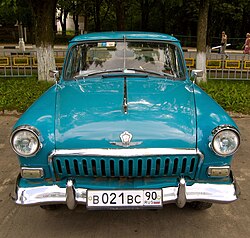Elektroshema Gaz 3309 Dizelj
• 3-speed automatic (initially) • 3-speed manual Dimensions 2,700 mm (110 in) Length 4,810 mm (189 in) Width 1,800 mm (71 in) Height 1,610 mm (63 in) Chronology Predecessor Successor The GAZ M21 Volga is an which was produced in the by ('Gorkovsky Avtomobilniy Zavod', in English: 'Gorky automobile factory') from 1956 to 1970. The first car to carry the name, it was developed in the early 1950s. Volgas were built with high (which gives it a specific 'high' look, contrary to 'low-long-sleek' look of Western cars of similar design), rugged, strong and forgiving engine, and on a scale unheard of in the 1950s. The Volga was stylistically in line with the major American manufacturers of the period in which it was introduced, and incorporated such then-luxury features as the reclining front seat, cigarette lighter, heater, windshield washer and 3-wave radio. When in 1959 the 6-cylinder line of GAZ cars was discontinued, Volga M-21 became the biggest and most luxurious car officially sold to individual owners in the USSR in large quantities, though its price was very high and made it unavailable for most car buyers.
Ram Big Horn/Lone Star with Bright White Clearcoat exterior and Diesel. VEHICLE REVIEWS Great Gas Mileage: 22 MPG Hwy. Discounts $3,309.
639,478 cars were produced in total. First Series (1956-58).
First Series 1956-1958 [ ] The design process leading to the GAZ 21 began in November 1953., head of the design team, was given a free hand to develop whatever he wanted to reach the objective of competing with American automobiles. The designer Lev Eremeyev decided to follow the fashion set by the,, and; the finished product bears a resemblance to the 1955 Mainline, although according to archive documents the latter was purchased for comparison and onroad testing by GAZ only in the mid-1954, after the prototypes of the GAZ-21 had already been built and tested. The prototype appeared in the first quarter of 1954, powered by an with (driven by chain) and cross-flow. Gas rc engines 4 stroke.
Since the OHV engine was not ready in time, production M21s had a 65 (48; 66 ) 2,432 cc (148.4 cu in) four, based on the 's. The Volga was offered with a three-speed, either (a 'crash box' with no ). Front suspension was, while the rear was a with; there were lever shock absorbers on all four corners. Lubrication was by a central oiling system, from a drum and foot-operated pump; the oil lines were prone to puncturing, and not all of the nineteen lubricated points were supplied equally. The Volga offered front seats able to fold flat (not unlike a contemporary option) and came standard with cigarette lighter and a radio (still optional on most U.S. There were three variants: the standard M21G, an M21B taxi (with a in place of the radio and bucket seats in front instead of a bench), and a tropical model, the M21GYU, all with the GAZ leaping deer.

Was a surprisingly good 0.42. The Volga made its public debut in 1955, with a three cars on a demonstration drive from Moscow to the Crimea, two automatic models and a manual. It was, however, still far from production-ready; in the first year, 1956, only five cars were assembled, the first on 10 October 1956. Full-scale production began in 1957, with a list price of 5,400. The new 1957 production cars, known as Series Ones, had a brand-new 2,445 cc (149.2 cu in) OHV engine, the first model produced by Zavolzhskiy Motorniy Zavod (, ZMZ). Unusual for the era, it had aluminum block and head, with gear-driven and of 6.6:1; it produced 70 hp (52 kW; 71 PS) at 4,000 and 123 (167 ) at 2,200 rpm.